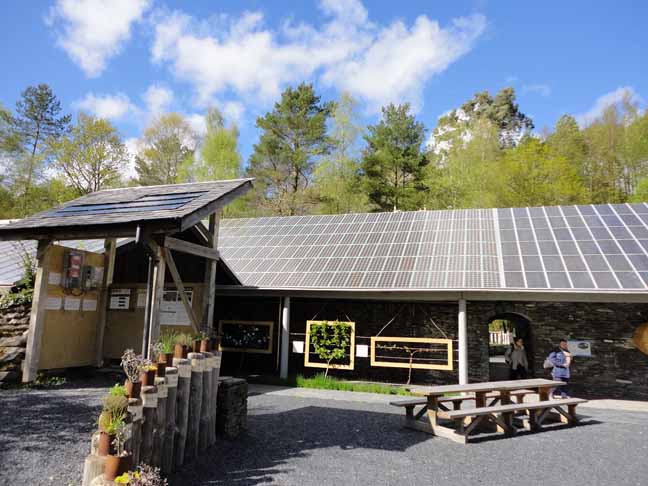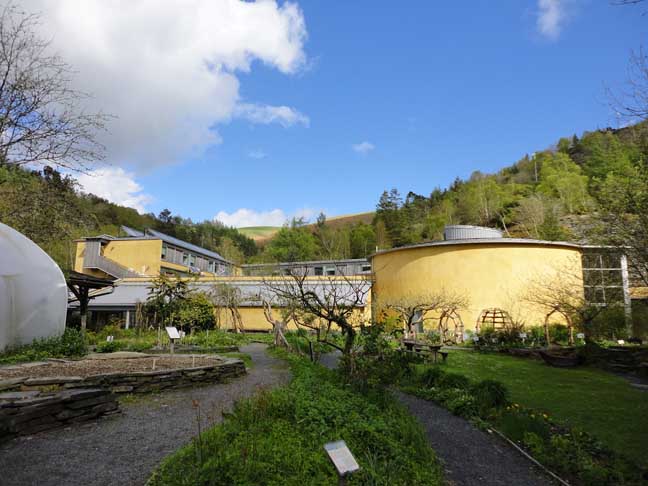This article is more than 1 year old
Rock reboot and the Welsh windy wonder: Centre for Alternative Technology
Biomass and the pit
“All living things can be composted”
The courtyard leads to the Wales Institute for Sustainable Education, the centre’s graduate school. This building has won architectural awards, both for its energy efficiency and its beauty.
Visitors can see the interior if no events are taking place, and it is worth doing so: the round Sheppard lecture theater, with a ‘moon disc’ ceiling window that can be opened and closed, would cheer up the dullest PowerPoints.
The interior wall looks like it's made of soil, because it is – compressed rammed earth, which absorbs heat from the sun and releases it slowly like a storage heater. Other parts of the building are made from hemp mixed with lime, as well as wood and high performance double glazing.
After the Worm Slide – a big metal slide which invites kids to consider that “All living things can be composted, even you!” – things take a turn for the technical. There is an exhibition on wind power, including a decommissioned set of turbine blades, and a set of interactive exhibits.
These let you try out different types of turbine blade in a wind tunnel and feel the lift produced by different designs, as well as an exercise bike where you can try to generate the 500W needed to run a personal computer – which is harder than it looks.

Big in the day: 20kW-worth of solar panels
Visitors can get free advice on renewable energy at the information centre, and during school holidays there are activities for children. But the centre also runs courses, and while some of these cover hobbies such as woodland crafts and gardening, others are professionally-focused.
Adam Tyler, a renewable energy consultant, lecturer and engineer, runs several of the engineering courses. He tells me the renewable energy systems course has plenty to offer IT professionals and facilities managers concerned with powering data centres and other substantial IT installations with renewable energy, and that the centre can also offer bespoke training and consultancy.
Tyler reckons it’s entirely possible to run a data centre reliably on renewable energy – through its Zero Carbon Britain work the centre believes this is true of the whole country, although the latter would require some significant changes in national lifestyle.
The trick in both cases is not to use just one type of renewable energy: “We can easily produce more than enough renewable energy, but it’s how you balance that,” Tyler tells me. “It needs to be a well thought-out integration of different technologies.”
The problem with using just one source is illustrated by those well-meaning types who plan to go off-grid by disconnecting from external power sources and using their own renewable energy.
Tyler’s verdict? “Living off-grid is one of the least green things you can do,” he says. Almost inevitably, it will mean some use of batteries to power things when the wind isn’t blowing and/or the sun isn’t shining.
“The only realistic way to do it would be to pick a site next to a big mountain with water running down it,” he says, and not just any mountain; reliable hydroelectric power generation requires 30m of vertical drop and a reliable flow of water.

The centre’s graduate school has won architectural awards for its energy efficiency and beauty
It’s worth noting that the centre is itself next to a big hill from which it obtains hydroelectric power, and has extensive solar and wind generating equipment. But after trying to do without in its early years, it connected itself to the national grid.
For many organisations, the simplest way to move to renewable energy is to use a supplier that buys or generates equivalent levels of green power to its customers’ usage, and supplies the grid. But that’s only part of the way to green computing: despite its fluffy image, the centre eschews cloud computing.
“That’s passing the energy off to someone else, and hoping they do it responsibly,” Tyler tells me, as many US east coast data centres are powered using cheap and dirty coal. A few, in places including Iceland and Scandinavia do better, by using hydroelectric and and geothermal energy.
